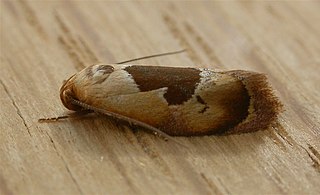Syngelechia is a genus of moths in the family Gelechiidae erected by Anthonie Johannes Theodorus Janse in 1958. Its only species, Syngelechia psimythota, was first described by Edward Meyrick in 1913. It is found in South Africa.

Hoplomorpha camelaea is a moth in the family Oecophoridae first described by Edward Meyrick in 1888. It is found in Australia, where it has been recorded from Victoria, Queensland, New South Wales and the Australian Capital Territory.

Lichenaula lichenea is a species of moth of the family Xyloryctidae. It is known in Australia from the Australian Capital Territory, New South Wales and Queensland.
Helcystogramma bicuneum is a moth in the family Gelechiidae. It was described by Edward Meyrick in 1911. It is known from north-eastern India and China.
Helcystogramma gradatum is a moth in the family Gelechiidae. It was described by Edward Meyrick in 1910. It is known from north-eastern India.
Helcystogramma rhabduchum is a moth in the family Gelechiidae. It was described by Edward Meyrick in 1911. It is found in Sri Lanka and India.
Helcystogramma septella is a moth in the family Gelechiidae. It was described by Philipp Christoph Zeller in 1852. It is found in Malawi, South Africa, Tanzania and the Gambia.
Photodotis spilodoma is a moth of the family Gelechiidae. It was described by Edward Meyrick in 1918. It is found in South Africa.
Polyhymno oxystola is a moth of the family Gelechiidae. It was described by Edward Meyrick in 1913. It is found in Mpumalanga, South Africa.
Antaeotricha trichonota is a species of moth of the family Depressariidae. It is found in Brazil and Paraguay.
Comotechna corculata is a moth in the family Depressariidae. It was described by Edward Meyrick in 1921. It is found in Peru and Pará, Brazil.
Comotechna dentifera is a moth in the family Depressariidae. It was described by Edward Meyrick in 1921. It is found in Brazil and Peru.
Comotechna parmifera is a moth in the family Depressariidae. It was described by Edward Meyrick in 1921. It is found in Peru and Pará, Brazil.
Comotechna scutulata is a moth in the family Depressariidae. It was described by Edward Meyrick in 1921. It is found in Brazil.
Comotechna semiberbis is a moth in the family Depressariidae. It was described by Edward Meyrick in 1921. It is found in Peru.
Eutorna eurygramma is a moth in the family Depressariidae. It was described by Edward Meyrick in 1906. It is found in Australia, where it has been recorded from Victoria, New South Wales and Tasmania.
Antaeotricha encyclia is a species of moth in the family Depressariidae. It was described by Edward Meyrick in 1915. It is found in Colombia.
Antaeotricha epignampta is a moth in the family Depressariidae. It was described by Edward Meyrick in 1915. It is found in Peru.
Moca aphrodora is a species of moth in the family Immidae first described by Edward Meyrick in 1922. It is found in Brazil and Peru.

Tingena hemimochla is a species of moth in the family Oecophoridae. It is endemic to New Zealand and has been observed in the North Island. Adults of this species are on the wing from December until March.


